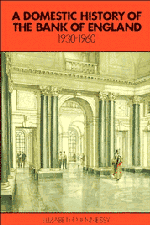Book contents
- Frontmatter
- Contents
- List of illustrations
- Foreword
- Acknowledgements
- Introduction
- 1 The Bank at war
- 2 The Accountant's Department
- 3 Exchange Control, 1939–1957
- 4 The note issue
- 5 The Printing Works
- 6 The Banking Department and the profitability of the Bank
- 7 The Cashier's Department
- 8 The Branches
- 9 Overseas, Economics and Statistics
- 10 The Establishment Department
- 11 The Secretary's Department
- Appendix Governors, Deputy Governors, Directors and Senior Officials, 1930–1960
- Notes
- Index
- Plate section
10 - The Establishment Department
Published online by Cambridge University Press: 05 March 2012
- Frontmatter
- Contents
- List of illustrations
- Foreword
- Acknowledgements
- Introduction
- 1 The Bank at war
- 2 The Accountant's Department
- 3 Exchange Control, 1939–1957
- 4 The note issue
- 5 The Printing Works
- 6 The Banking Department and the profitability of the Bank
- 7 The Cashier's Department
- 8 The Branches
- 9 Overseas, Economics and Statistics
- 10 The Establishment Department
- 11 The Secretary's Department
- Appendix Governors, Deputy Governors, Directors and Senior Officials, 1930–1960
- Notes
- Index
- Plate section
Summary
The original organisation of the Bank in three Departments – Cashier's, Accountant's and Secretary's – remained undisturbed for two hundred years until the institution of the Auditor's Department in 1894 as the result of the indiscretions of a Chief Cashier, Frank May, which had come to light the previous year. There was no special Department to look after the interest of the staff, but their welfare and the maintenance of the premises in which they worked had always been an important aspect of the policy of the Bank. The Deputy Governor had an overall, if largely undefined, staff responsibility – ‘You cannot think what it means’, said Norman of his own Deputy Governorship, ‘to be father and mother to five thousand souls’ – but necessarily had many other pressing concerns. A Staff Committee was formed in 1918 by the amalgamation of six Committees some of which had been in existence since the eighteenth century: its members were all Directors and it met regularly every month except August to discuss details of staff policy and practice. In July 1919 the Advisory Council of Directors and Staff was formally constituted as a result of growing discontent on the part of the clerks about their treatment during and after the First World War. A Director was Chairman, five others, at least two of whom were Directors, were appointed by Court, and five selected by the staff by secret ballot and representing different grades.
- Type
- Chapter
- Information
- A Domestic History of the Bank of England, 1930–1960 , pp. 324 - 369Publisher: Cambridge University PressPrint publication year: 1992



